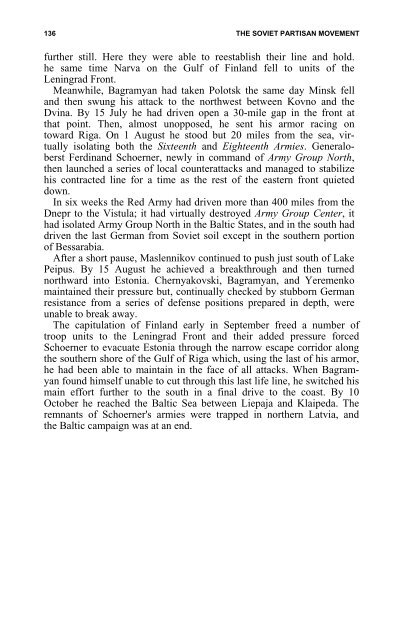the soviet partisan movement 1941-1944 by edgar m. howell
the soviet partisan movement 1941-1944 by edgar m. howell
the soviet partisan movement 1941-1944 by edgar m. howell
You also want an ePaper? Increase the reach of your titles
YUMPU automatically turns print PDFs into web optimized ePapers that Google loves.
136 THE SOVIET PARTISAN MOVEMENT<br />
fur<strong>the</strong>r still. Here <strong>the</strong>y were able to reestablish <strong>the</strong>ir line and hold.<br />
he same time Narva on <strong>the</strong> Gulf of Finland fell to units of <strong>the</strong><br />
Leningrad Front.<br />
Meanwhile, Bagramyan had taken Polotsk <strong>the</strong> same day Minsk fell<br />
and <strong>the</strong>n swung his attack to <strong>the</strong> northwest between Kovno and <strong>the</strong><br />
Dvina. By 15 July he had driven open a 30-mile gap in <strong>the</strong> front at<br />
that point. Then, almost unopposed, he sent his armor racing on<br />
toward Riga. On 1 August he stood but 20 miles from <strong>the</strong> sea, virtually<br />
isolating both <strong>the</strong> Sixteenth and Eighteenth Armies. Generaloberst<br />
Ferdinand Schoerner, newly in command of Army Group North,<br />
<strong>the</strong>n launched a series of local counterattacks and managed to stabilize<br />
his contracted line for a time as <strong>the</strong> rest of <strong>the</strong> eastern front quieted<br />
down.<br />
In six weeks <strong>the</strong> Red Army had driven more than 400 miles from <strong>the</strong><br />
Dnepr to <strong>the</strong> Vistula; it had virtually destroyed Army Group Center, it<br />
had isolated Army Group North in <strong>the</strong> Baltic States, and in <strong>the</strong> south had<br />
driven <strong>the</strong> last German from Soviet soil except in <strong>the</strong> sou<strong>the</strong>rn portion<br />
of Bessarabia.<br />
After a short pause, Maslennikov continued to push just south of Lake<br />
Peipus. By 15 August he achieved a breakthrough and <strong>the</strong>n turned<br />
northward into Estonia. Chernyakovski, Bagramyan, and Yeremenko<br />
maintained <strong>the</strong>ir pressure but, continually checked <strong>by</strong> stubborn German<br />
resistance from a series of defense positions prepared in depth, were<br />
unable to break away.<br />
The capitulation of Finland early in September freed a number of<br />
troop units to <strong>the</strong> Leningrad Front and <strong>the</strong>ir added pressure forced<br />
Schoerner to evacuate Estonia through <strong>the</strong> narrow escape corridor along<br />
<strong>the</strong> sou<strong>the</strong>rn shore of <strong>the</strong> Gulf of Riga which, using <strong>the</strong> last of his armor,<br />
he had been able to maintain in <strong>the</strong> face of all attacks. When Bagramyan<br />
found himself unable to cut through this last life line, he switched his<br />
main effort fur<strong>the</strong>r to <strong>the</strong> south in a final drive to <strong>the</strong> coast. By 10<br />
October he reached <strong>the</strong> Baltic Sea between Liepaja and Klaipeda. The<br />
remnants of Schoerner's armies were trapped in nor<strong>the</strong>rn Latvia, and<br />
<strong>the</strong> Baltic campaign was at an end.
















